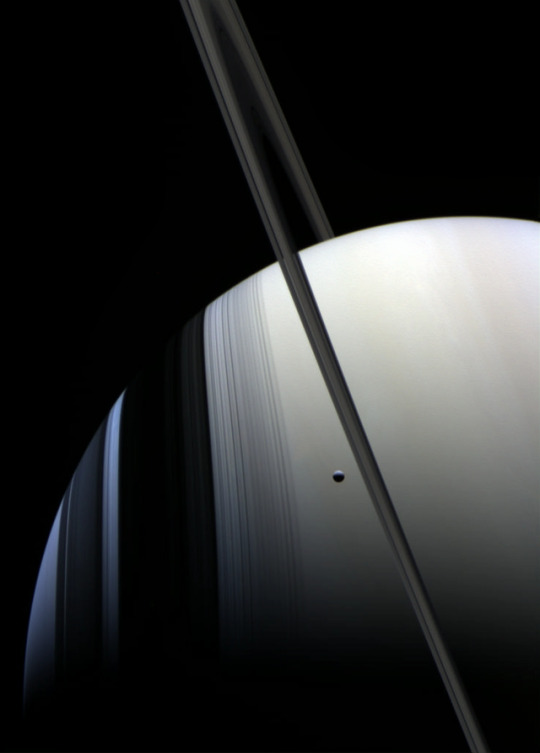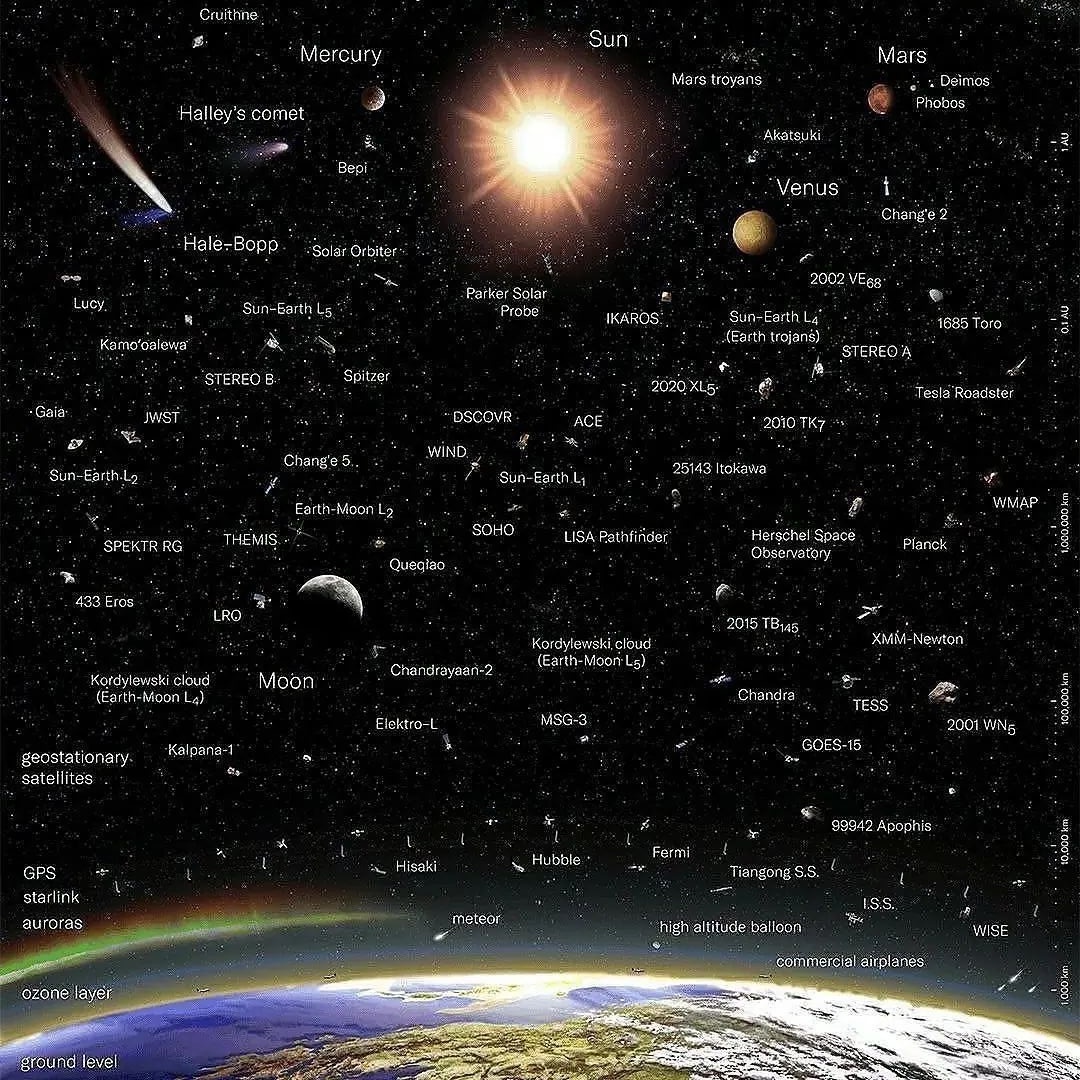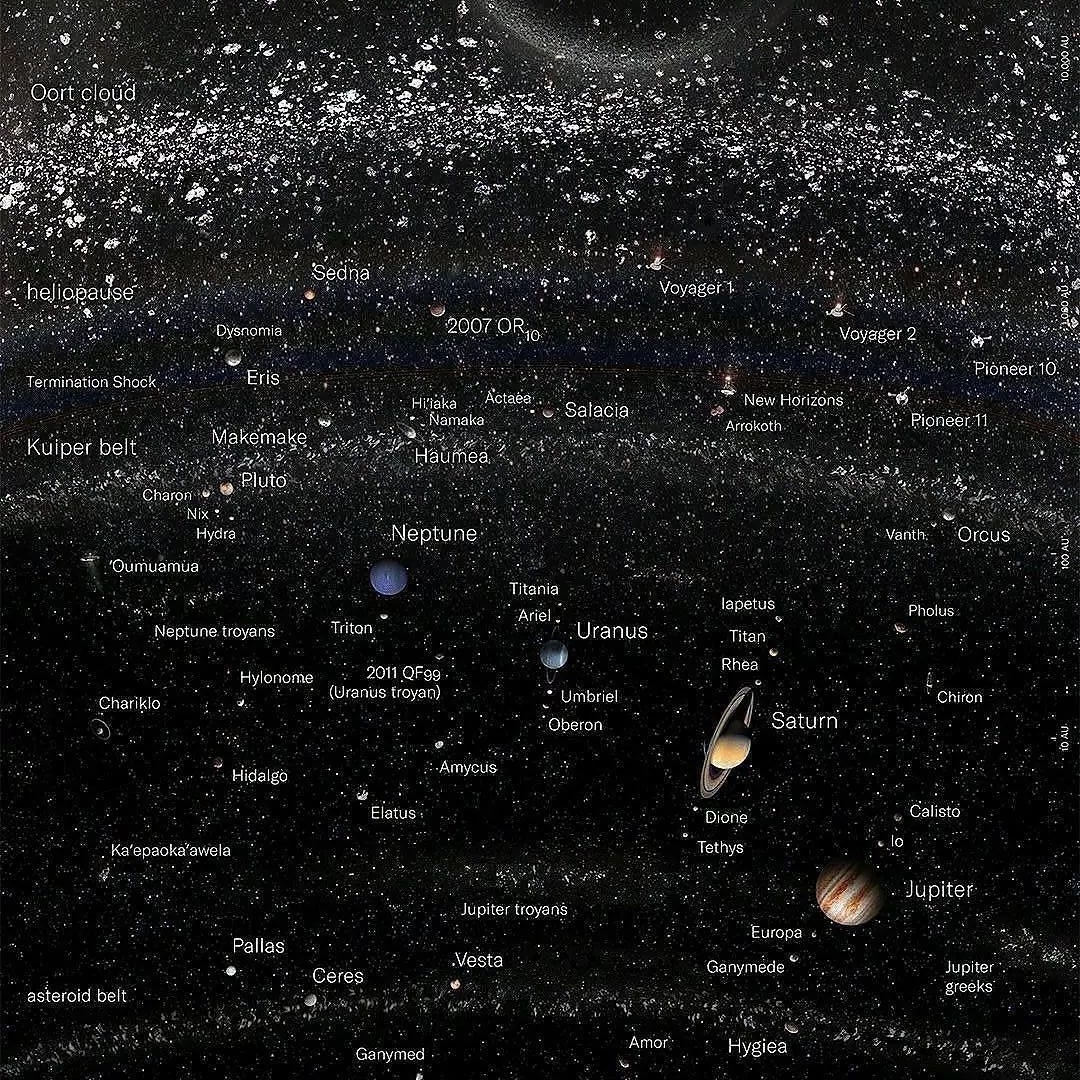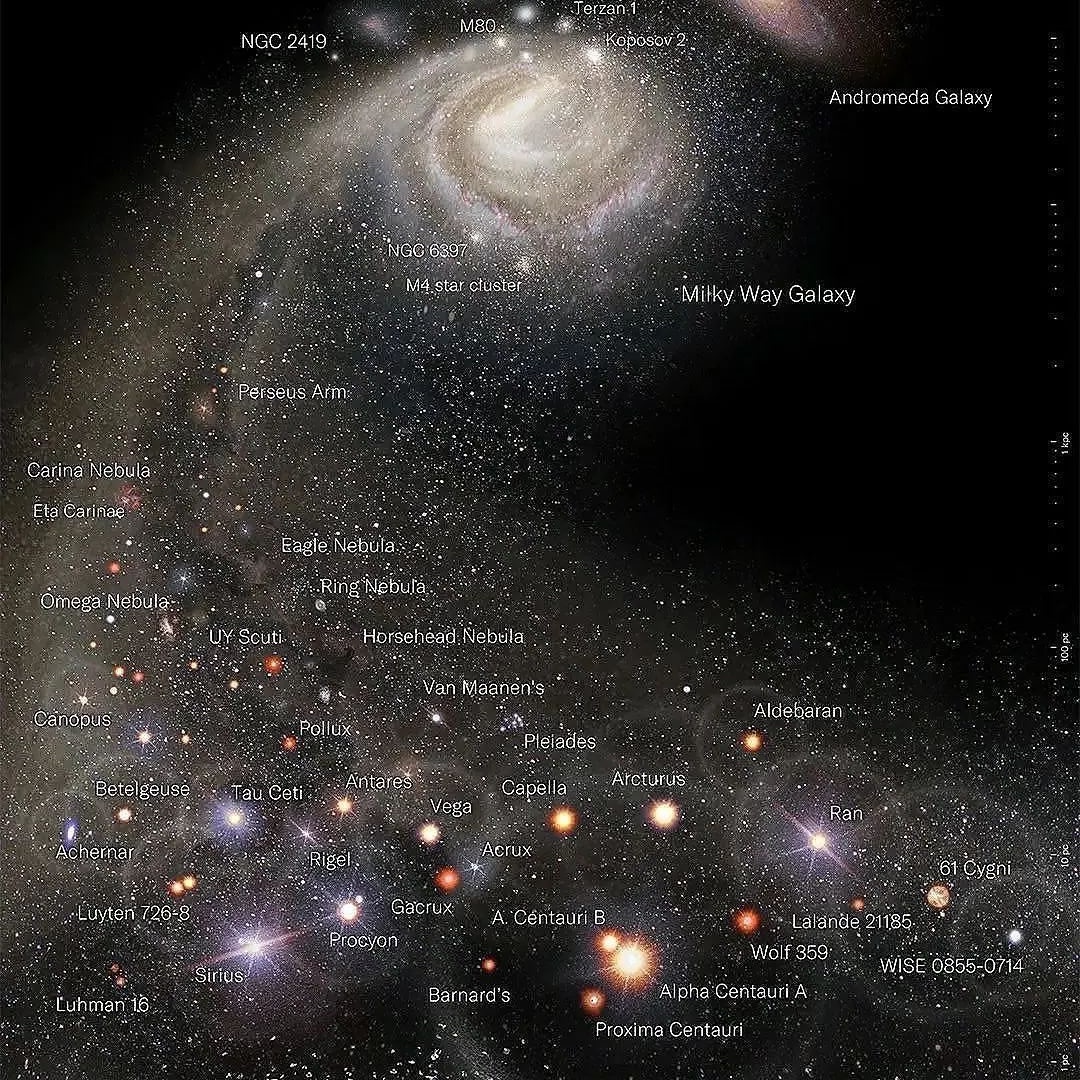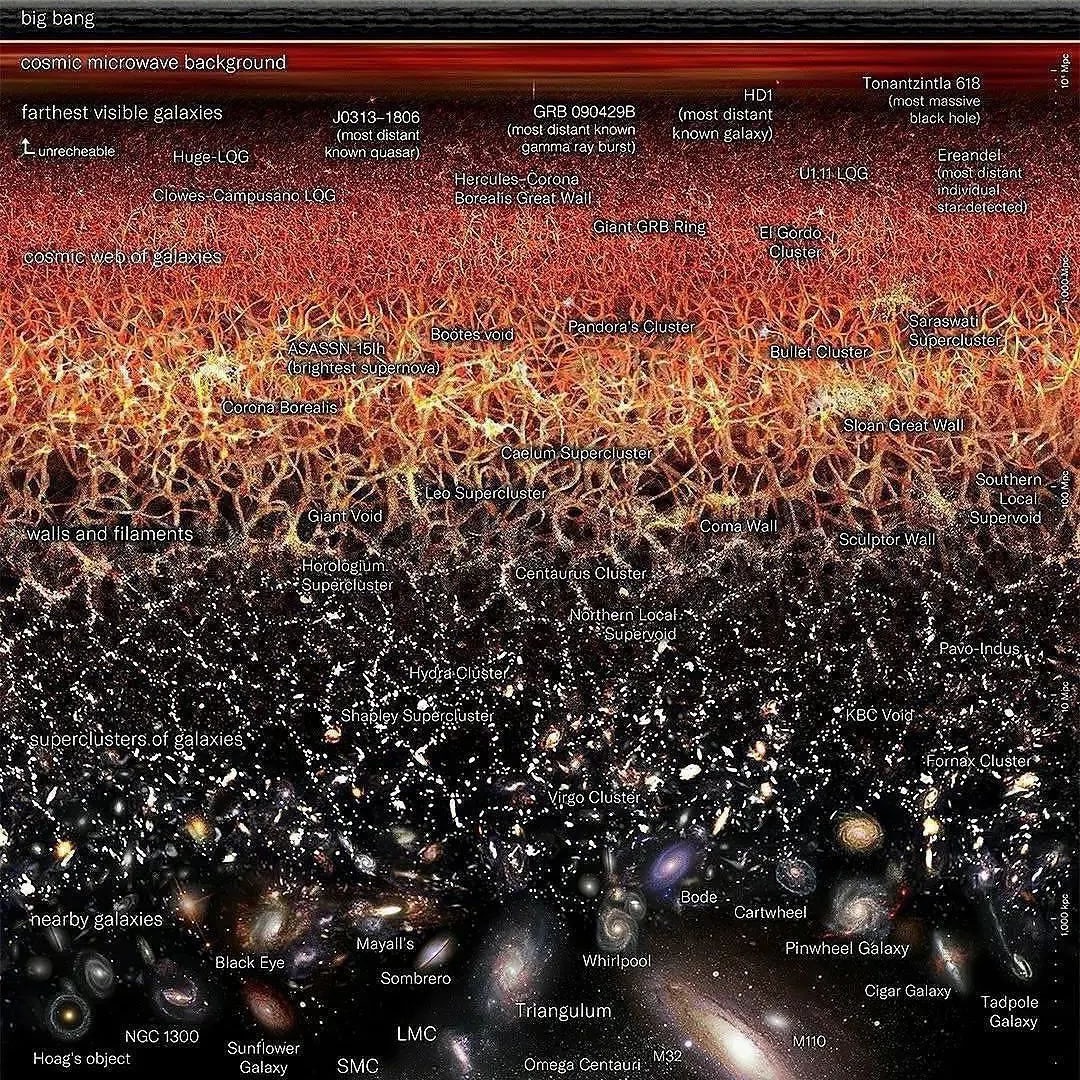12-Year timelapse of four planets orbiting their host star HR 8799, 129 light years away from Earth
I Am Eternally Grateful…
Science!
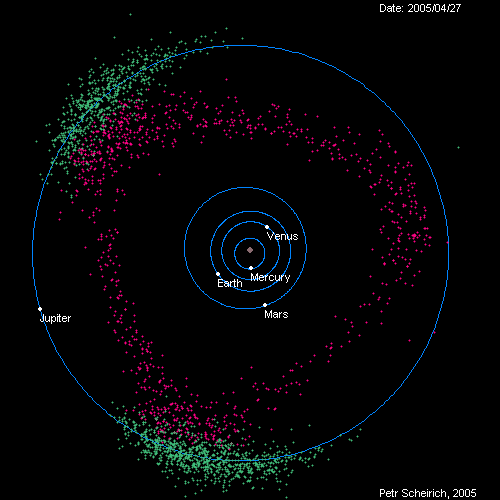
From Tumblr:
Hundreds of Science Fiction novels
Uncountable hours of hobbyist studies of Astrophysics
Documentaries. Classes.
This. Is what finally gets me to see how IMMENSE Jupiter really is
It really is like 10% of the way to being a Star…
It looks like there's enough material for a whole additional planet after Mars, that's just… being perpetually perturbed out of a proper accretion disk by Jupiter's big fat fucking gravity well.
So why are the red objects in a triangle? And how come the green clusters are at only two of the points?
Because of the interaction between Jupiter's gravity and the Sun's gravity, only certain orbits are stable. Specifically, orbital periods close to – but just a little longer or a little shorter than – Jupiter's are unstable. This actually holds true to some extent for all the IAU-recognized planets, though it's most obvious with Jupiter. The green clusters are known as the Trojans (called that because they were named after figures from the Trojan War – with two exceptions, those at the leading point are named after figures on the Greek side and those at the trailing point are named after figures on the Trojan side), which surround two of the five Lagrange Points, known as the L4 and L5 points, which are 60 degrees ahead and behind it. A diagram using the Earth-Moon system (not to scale):
The principle is the same for any system where the first object is much larger than the second object, with the same angular separations
Anything at one of those points will have a stable orbit equal in length to the Earth's orbit. However, only the L4 and L5 are stable in the long term. Objects that are close to the L4 and L5 point will, over the long run, kind of circle around them, with an orbit that varies over time, being sometimes slightly shorter than and sometimes slightly longer than the second object, but averaging over the long run exactly the same, causing their angular distance from Jupiter to fluctuate over time, but always around 60 degrees. Because of Jupiter's large mass, it has the most dramatic effect. A large number of asteroids have gotten caught in orbits around its L4 and L5 points. These are the ones that are marked in green on the above gif. Jupiter has over 10,000 total known asteroids between its L4 and L5 points, while most of the other planets have a few in theirs. Earth, for example, has two known asteroids in its L4 point, but none in its L5 point. Neptune has a total of 28 known asteroids between its L4 and L5 points. Mercury and Saturn are not known to have any. Theoretically, it might be possible in some other solar system for an actual planetary-mass object to be located in the L4 or L5 point of a larger Jovian, though no such system has been discovered to date
The red asteroids are known as the Hilda asteroids (named after their largest member, the asteroid 153 Hilda). Unlike the Trojans, their orbits are not in a 1:1 ratio, but rather, in a 3:2 ratio, that is, they orbit three times for every two of Jupiter's orbits (on average). Their aphelion (furthest point from the Sun) approaches Jupiter's orbit, but their orbits are such that those aphelions are reached when Jupiter is either 60 degrees ahead, 180 degrees, or 60 degrees behind – as their orbital period is 2/3 of Jupiter's orbit, each time it reaches the aphelion, the angular separation between it and Jupiter is 120 degrees less – i.e., if the first time it is on the opposite side of the Sun from Jupiter, the second time it will be 60 degrees ahead, the third time it will be 60 degrees behind, and then repeating the fourth time. Hence, when you map out all of them, those at their furthest approach from the Sun – coming approximately to Jupiter's orbit – are either 60 degrees behind Jupiter, 60 degrees ahead, or 180 away, and those that are at their closet point are between the Sun and Jupiter, 120 degrees ahead, or 120 degrees behind, with those at intermediate distances being at intermediate angles. So, each individual asteroid follows an elliptical orbit, but the sum total of all their positions creates a rough triangle which appears to orbit with Jupiter
Other orbits that are close to Jupiter's, but not in those 1:1 or 2:3 ratios, don't last long. They'll either end up getting caught up in the 1:1 or 2:3 ratio, or end up getting flung out of those orbits ending up in significantly smaller or significantly larger orbits. Jupiter's orbit also causes certain gaps in the asteroid belt around orbital periods that would be unstable with Jupiter's influence.
Please note the image above is not actually the entire asteroid belt. The main asteroid belt is a circular shape. A more complete, but non-animated image:
SCIENCE!
All 116 Images Embedded Into Voyager 1's Golden Record
Science!
The More You Know…
Vaccine Breakthrough Means No More Chasing Strains
Scientists at UC Riverside have demonstrated a new, RNA-based vaccine strategy that is effective against any strain of a virus and can be used safely even by babies or the immunocompromised. Every year, researchers try to predict the four influenza strains that are most likely to be prevalent during the upcoming flu season. And every year, people line up to get their updated vaccine, hoping the researchers formulated the shot correctly. The same is true of COVID vaccines, which have been reformulated to target sub-variants of the most prevalent strains circulating in the U.S. This new strategy would eliminate the need to create all these different shots, because it targets a part of the viral genome that is common to all strains of a virus. The vaccine, how it works, and a demonstration of its efficacy in mice is described in a paper published today in the Proceedings of the National Academy of Sciences. "What I want to emphasize about this vaccine strategy is that it is broad," said UCR virologist and paper author Rong Hai. "It is broadly applicable to any number of viruses, broadly effective against any variant of a virus, and safe for a broad spectrum of people. This could be the universal vaccine that we have been looking for."
Falling Into A Black Hole
Space and Time
Just Sayin'
For Scale
Life Imitates Art
Last year astronomers at NASA announced they had discovered a sextuple star system, i.e. six stars that perform an intricate dance around a common center of gravity.
I find this fascinating because this is exactly the type of system described in Isaac Asimov's classic work, Nightfall.
In 1941, Astounding Science Fiction magazine published a short story by a little-known writer named Isaac Asimov. The story was called Nightfall, and many years later it has long been recognized as a classic; its author a legend. The Gran Master of Science Fiction eventually teamed with Robert Silverberg, one of the field's top award-winning authors, to explore and expand an apocalyptic tale that is more spellbinding today than ever before—Nightfall: The Novel.
Imagine living on a planet with six suns that never experiences darkness. Imagine never having seen the stars. Then, one by one the suns start to set, gradually leading into darkness for the first time ever. Kalgash is a world on the edge of chaos, torn between the madness of religious fanaticism and the unyielding rationalism of scientists. Lurking beneath it all is a collective, instinctual fear of the darkness. For Kalgash knows only the perpetual light of day; to its inhabitants, a gathering twilight portends unspeakable horror. And only a handful of people on the planet are prepared to face the truth, their six suns are setting all at once for the first time in over two thousand years, signaling the end of civilization as it explodes in the awesome splendor of Nightfall.
Encompassing the psychology of disaster, the tenacity of the human spirit, and, ultimately, the regenerative power of hope, Nightfall is a tale rich in character and suspense that only the unique collaboration of Isaac Asimov and Robert Silverberg could create.
More than one attempt has been made to bring this story to the screen, each time resulting in utter failure. My take on the most recent one is here.
Andromeda Moves In
Not that humanity will even be around to witness this, but these images show what things may look like as the inevitable collision and merger of the Andromeda and Milky Way galaxies takes place.
The last two images are a bit optimistic because the Earth will have long since been consumed by the sun as it enters its red giant phase in around 5 billion years.
In Case You've Ever Wondered…
…how the plane of our solar system is oriented to the plane of the Milky Way.
Because I have.
But then, I'm an astronomy geek. Have been since I was a wee young thing. But I'd always wondered how the solar system was oriented in regard to the galaxy itself, since it seemed improbable that everything was oriented in the same direction.
Our Colorful Moon
The Latest Weirdness From the Surface of Mars
Remind Me Again…
The Latest from James Webb
NASA's James Webb Space Telescope's mid-infrared view of the Pillars of Creation strikes a chilling tone. Thousands of stars that exist in this region seem to disappear, since stars typically do not emit much mid-infrared light, and seemingly endless layers of gas and dust become the centerpiece. The detection of dust by Webb's Mid-Infrared Instrument (MIRI) is extremely important – dust is a major ingredient for star formation.
Credits: NASA, ESA, CSA, STScI; Joseph DePasquale (STScI), Alyssa Pagan (STScI)
Quetzalcoatlus northropi
Science!
The Cosmos
Just Think About This For a Moment…
Yes, By All Means…
Feeling Insignificant Yet?
Putting Things Into Perspective
The outline of the continental United States superimposed over the great hexagon at Saturn's North Pole:
If you're not humbled by that, here's the entire North American continent next to Jupiter's Great Red Spot:
But Christians, please…tell me again how your god is so obsessed with where I put my penis. I'll wait.
But Human Beings Are the Center of the Universe…
If You Could Have Dinner With Three, Who Would You Choose?
Science!
Take a good look: this is the black hole at the center of our galaxy.
In the inset image, gas in the glowing orange ring surrounds the black hole's event horizon, a boundary from which nothing can escape. The ring is created by light bending in the intense gravity around Sagittarius A*, which has a mass some four million times greater than our Sun. This groundbreaking image of Sagittarius A* was taken by the Event Horizon Telescope team with data from telescopes around the world. After the EHT's iconic image of M87*, released in 2019, this is only the second time a supermassive black hole has been directly observed with its shadow.
The wider look at the space around Sagittarius A* includes data contributed by several NASA missions. The orange specks and purple tendrils were captured in infrared light by the Hubble Space Telescope, and the blue clouds represent data from our orbiting Chandra X-ray Observatory.
Fall in to the whole story: https://www.nasa.gov/mission_pages/chandra/images/sagittarius-a-nasa-telescopes-support-event-horizon-telescope-in-studying-milky-ways.html
[Source]

